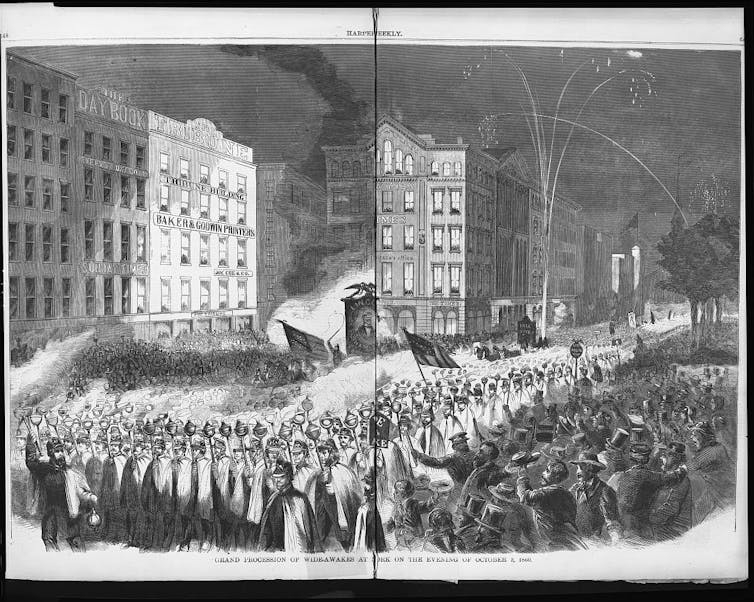The Rise of the Wide Awakes: How 19th-Century Media Fueled a Nation’s Division
The popular narrative of a bygone era of balanced and reasoned journalism is often romanticized. The reality, however, is far more complex. Examining the tumultuous political landscape of the mid-1800s, particularly during the run-up to the American Civil War, reveals a media environment rife with partisanship, sensationalism, and the rapid spread of misinformation—a landscape strikingly similar to the challenges we face today. The story of the Wide Awakes, a largely forgotten political movement, illuminates how this volatile media ecosystem contributed to the nation’s deepest division.
The mid-19th century witnessed an explosion in print media. Fueled by rising literacy rates, newspapers proliferated, reaching a staggering 4,000 publications by 1860. These publications catered to diverse tastes, ranging from the satirical New York Herald to the abolitionist Liberator, reflecting a spectrum of political viewpoints and journalistic styles. This era lacked the concept of objective reporting. Papers were openly partisan, often financed by political parties, their content fueling public discourse and shaping opinions. This partisan press controlled even the printing of ballots, blurring the lines between media and electoral processes. The advent of the telegraph, a groundbreaking technology for its time, further amplified the reach of these newspapers, allowing news and opinions to travel across the nation with unprecedented speed.
This newly interconnected media landscape became a battleground for the debate over slavery. Previously a localized issue, the national reach of newspapers brought the issue to the forefront of national conversation. Abolitionist publications like the National Era, which first serialized Harriet Beecher Stowe’s “Uncle Tom’s Cabin,” galvanized anti-slavery sentiment in the North. Conversely, pro-slavery publications like “De Bow’s Review” advocated for the expansion of slavery, spreading their message far and wide. The absence of neutral arbiters and the profit-driven model of the press meant that outrage, both legitimate and manufactured, became a powerful currency.
Emerging from this charged environment came the Wide Awakes, a youth movement born out of the Republican Party’s anti-slavery platform. Originating in Connecticut, a state with high literacy rates and widespread newspaper circulation, the Wide Awakes adopted their name from a newspaper article praising the Republicans’ energetic campaigning. With their distinctive uniforms, torchlit rallies, and the symbol of an open eye, they quickly captured the attention of the nation. Their primary focus was often not the intricacies of slavery policy, but the defense of a “Free Press”—one unfettered by pro-slavery influences.
The Wide Awakes leveraged the power of the press to expand their influence. Newspapers served as organizing tools, informing members about the formation of new clubs and coordinating activities. This symbiotic relationship between the movement and the press fueled rapid growth, with membership estimated at 500,000 within months – equivalent to approximately 5 million today. The press actively promoted the Wide Awakes, urging readers to join and contributing to their meteoric rise.
However, this same media network also became a conduit for fear and misinformation. Southern newspapers, fueled by the Wide Awakes’ rapid expansion and often exaggerated accounts of their activities, painted them as a dangerous paramilitary force, stoking anxieties of a Northern invasion. Misinformation spread like wildfire, with false claims that the Wide Awakes were primarily composed of Black members planning a race war gaining traction in the South. The partisan nature of the press magnified these distortions, contributing to a climate of paranoia and suspicion.
By the time Lincoln won the 1860 election, the Wide Awakes had become a powerful symbol, both of hope for the anti-slavery movement and of fear for those who supported slavery or its continuation. Secessionist newspapers seized upon these anxieties, using the perceived threat of the Wide Awakes to bolster their arguments for secession. The Weekly Mississippian, for instance, published headlines warning of a “WIDE-AWAKE INVASION ANTICIPATED” on the very day Mississippi declared secession. Conversely, Wide Awake-supporting newspapers urged their readers to arm themselves in response to the growing secessionist movement, escalating the rhetoric and pushing the nation closer to war.
The story of the Wide Awakes highlights the complex and often dangerous interplay between a rapidly evolving media landscape and escalating political tensions. Within a mere 16 years of the telegraph’s introduction, the nation erupted into civil war. While the fundamental cause of the conflict was undeniably the fight over slavery, the press played a significant role in shaping public opinion, spreading disinformation, and amplifying existing divisions. The mid-19th century offers a cautionary tale of a society grappling with both the unprecedented power of information dissemination and the dangers of a fragmented and deeply partisan media environment.
This historical perspective offers valuable insights for understanding the present. Today, we face similar challenges with the rise of social media and the proliferation of misinformation. Like the 19th-century press, social media has the power to connect people across vast distances, amplify diverse voices, and mobilize social movements. However, it also carries the risk of exacerbating polarization, spreading disinformation, and undermining trust in established institutions. The story of the Wide Awakes reminds us that the media landscape, while constantly evolving, is not an unstoppable force. It is a reflection of societal tensions, and its power must be recognized, understood, and responsibly managed. Just as the 19th-century press needed to be tamed, so too must we navigate the complexities of our contemporary media environment, striving to foster informed public discourse and protect the integrity of democratic processes.


